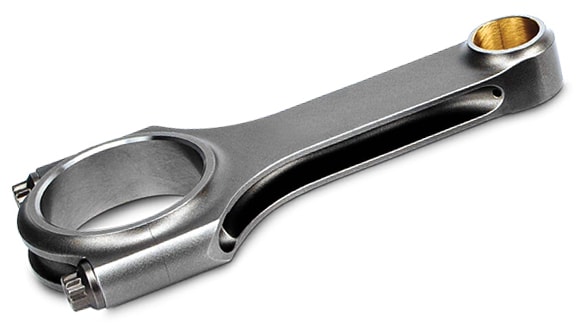Simple Tech: Connecting rods explained
As you know from previous editions of Simple Tech, the piston converts the heat energy of combustion into a more useful up and down, or reciprocating motion. But what we need to produce forward motion is to convert this reciprocating motion into rotation. And that role is given to the bit that connects the piston to the crankshaft, called simply, the connecting rod. The most common place, it used to be, to see this was the steam locomotive where massive connecting rods rotate the wheels (on steam locomotives, the wheels function as the crankshaft in effect).
In internal combustion engines, the shape of the con rod is pretty distinctive. It looks like a rod that joins a usually circular end with a much larger circular end. In keeping with the simplicity of the nomenclature, the larger end is called the Big End. The smaller of the two ends connects to the underside of the piston with a wrist pin (also called a gudgeon pin). A bearing allows the rod to swivel around the piston.

The Big End is connected to the crankshaft. The circular hole is usually split into two halves, the bottom bit, which comes off and is called the bearing cap is secured to the con rod by bolts. This bit mounts on the crank pin. The crank pin is, in the simplest terms, the end of lever arm which the con rod uses to generate rotational motion in the crank shaft.
The role of the con rod might look simple on the face of it, but it is a very stressful existence. The rod stretches and compresses in every alternate stroke of the combustion cycle as it pushes the crankshaft and then is pulled back up by the rising piston. This requires a strong material but without too much weight since it is a moving part and weight consumes energy. Which is why most con rods are made of steel with alloy formulations or surface treatments used to bolster its strength. High performance engines can have much lighter forged aluminium or even titanium con rods. Con rods can also have internal bores and other mechanisms created for lubrication.
Ordinarily, a con rod connects one piston to a crank pin but there are more complicated arrangements possible. In multi cylinder engines, inlines and boxers tend to follow the simplest arrangement - one con rod per piston. But some V-twins can have forked con rods (the master is thicker and the slave joins just above the big end).
Next time, the last and perhaps the biggest part of the engine, crankshafts.
For more Simple Tech stories, click here.